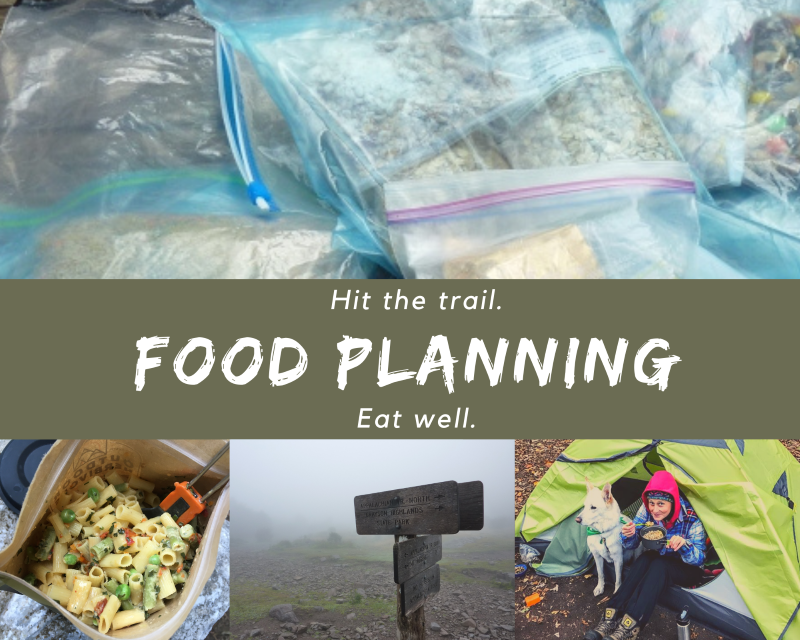Meal Planning & Eating Well
Meal preparation is an important step in planning a backpacking trip. When you’re in the wilderness, you want to eat food that tastes good and nourishes you. You want to make sure you pack out foods that can withstand the conditions of outdoor travel and require minimal cooking effort. These tips will help you with your meals and snacks for the trail.

What Foods to Pack
Freeze-dried and dehydrated backpacking meals can be pricey, however they are lightweight, convenient, and deliver on sustenance and taste. Some foods from the grocery store will also work for the trail. When purchasing grocery store food, look for items with cook times of 10 minutes or less. Check the nutritional panel to determine if the food contains enough calories. A good rule is to look for meals containing at least 100 calories per ounce. You can also boost the calorie content of foods by adding healthy fats such as nuts, seeds, and olive oil. Planning food for expeditions and marathons will require extra planning.
Storing Homemade Backpacking Food
Backpacking Food Preparation Tips
Everyday Grocery Items for Backpacking
Bulk Dried Backpacking Food
Vegetarian & Vegan Expeditions Food Tips
Planning Food for a Thru-Hike
Planning Food for a Vegan or Vegetarian Thru-Hike
Resupply: How to Mail Food for a Thru-Hike and Resupply Articles by Outdoor Herbivore
Storing Food: Bear Canisters
As more humans venture out to the wilderness, bears are becoming more habituated to the presence of humans. If bears associate humans as a source of carrying food, it can lead to dangerous interactions. Regulations vary between National Parks and National Forests on where bear canisters are required and which ones are approved.
Bear Canister Requirements in the USA
Food Considerations: No Cook, No Stove
Leave behind the backpacking stove to simplify meal preparation and reduce pack weight. Going stove-less is possible to do and still have a meal. Besides the obvious choices such as meal bars and gorp, here are other options to consider.
No Cook Meals
How Much Food to Pack
Pack more food than you might need. Instead of packing extra meals, pack additional snacks or no-cook meals. Doing so means you can still eat if you run out of stove fuel or are too tired to fire up the stove. A general guide is to pack 1.5 - 2 pounds of food per person daily for average body weight; otherwise, pack more food or supplement meals using healthy, high calories food such as olive oil.
Backpacking Food Packing Tips
Food Considerations: Cold Weather
Winter backpacking can require an additional 500 – 1,000 calories per day. You will need to focus on high-fat foods to meet your energy demands. Eating nutritionally sound foods will make a difference in your ability to stay warm and energized. Your appetite may decrease at higher elevations and cold conditions. Be mindful of the potential to adjust your food choices accordingly by adding simple digestable foods such as smoothies, soups, and calorie-dense snacks for colder stretches.
Food for Winter Backpacking
Why Soup makes the Ultimate Winter Backpacking Meal
Food Considerations: Hot Weather
Besides staying hydrated in hot weather, you need to consume foods high in electrolytes to replace that lost by heaving sweating.Food for Summer Backpacking
Cold Meals for Backpacking
Food Considerations: Minimize Pain
Do you suffer from sore hips, neck aches, knee pain, and leg cramps on the trail? Pain is undoubtedly a common ailment experienced by most hikers. Fortunately, nature has provided us with plenty of trail-worthy foods to help minimize and alleviate inflammation and pain. Find out what spices and foods you should pack to help fight the ache.Foods to Eat that Minimize Pain and Inflammation
Cooking the Right Way
Running out of fuel mid-hike with a backpack full of freeze-dried entrées is a common concern. The boil-soak method of backcountry cooking is extremely efficient because it uses less fuel and water. Here are a few strategies to conserve stove fuel.
Tips for Cooking on the Trail
Cooking at High Altitude
When you are hiking at altitudes above 5,000 feet, and your trail food comes out too watery or crunchy, the most likely cause is that you didn’t allow the meal to soak long enough to absorb the water. Soaking dried food longer is necessary. The general guide is to add 1 minute of rehydration (hot soak) time for every 1,000 feet of elevation gain above 5,000 feet.
Tips for Cooking Backpacking Foods at High Altitude
How to Eat
Champion Chewing on the Trail
Washing Dishes in the Backcountry
Don’t risk your health by consuming hot meals heated inside flimsy plastic bags. We always encourage backpackers to use the proper cooking equipment for handling boiling water and hydrating food. This list of tips should help you with cleaning up while backpacking.
Doing Dishes on the Trail
